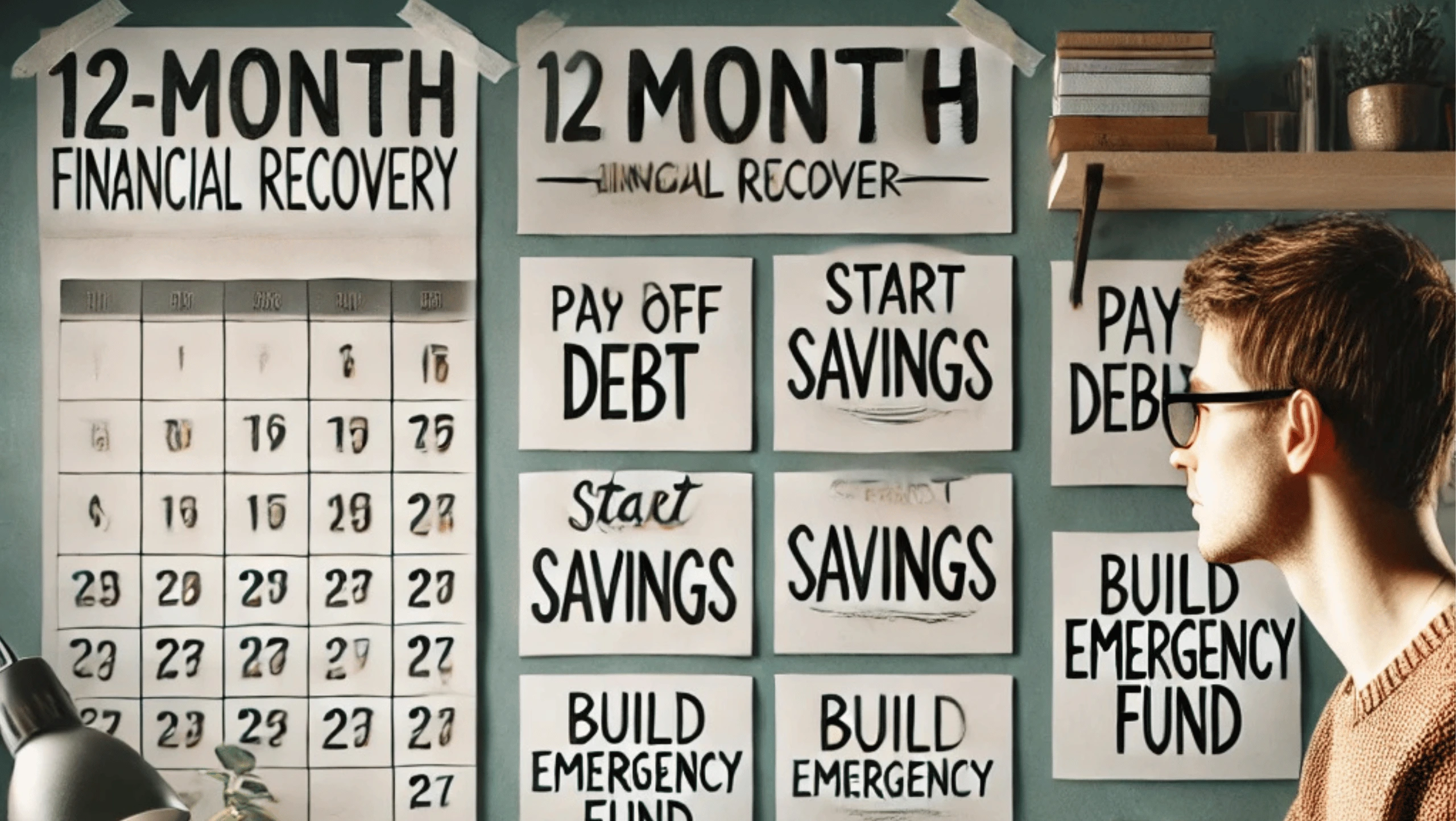If you’re finding yourself living from paycheck to paycheck, you’re not alone. Many people face financial stress, struggling to balance bills, savings, and unexpected expenses. However, breaking this cycle is entirely possible with a strategic plan, commitment, and discipline. This 12-month financial recovery plan will guide you through the process of transforming your financial situation from surviving to thriving, turning paycheck-to-paycheck living into a journey toward financial stability and savings.
Month 1: Assess Your Current Financial Situation
Before you can improve your financial standing, it’s crucial to understand where you are financially. Start by gathering all your financial statements—bank accounts, credit cards, bills, and debts—and creating a detailed picture of your income and expenses. List all your fixed costs, such as rent, utilities, and loan payments, along with variable expenses, such as groceries, entertainment, and shopping. Once you’ve reviewed your spending, categorize these expenses into essentials and non-essentials. Understanding your current financial situation is the first step toward gaining control over your money.
Month 2: Create a Budget and Stick to It
A budget is your roadmap to financial recovery. In the second month, create a realistic budget that accounts for all your income and expenses. The goal is to live within your means, so prioritize paying for essential expenses first, followed by debt repayment, and then allocate a small portion toward savings. Apps like Mint or You Need A Budget (YNAB) can help you track your spending and identify areas where you can cut back. Begin by trimming unnecessary non-essential expenses and focusing on building savings, even if it’s just a small amount. Remember, budgeting is a habit, so be consistent and adapt it as your financial situation evolves.
Month 3: Build an Emergency Fund
A vital aspect of financial recovery is building an emergency fund, which can provide a buffer in case of unexpected expenses or job loss. In the third month, start by setting aside small, manageable amounts into a separate savings account. Aim for an emergency fund of at least $1,000 by the end of the month. This fund will give you peace of mind and help prevent you from relying on credit cards or loans in times of need. If $1,000 feels unattainable initially, set a smaller goal and gradually increase your savings as your income grows.
Month 4: Pay Off High-Interest Debt
Debt, especially high-interest debt like credit card balances, can make it difficult to make progress financially. In month four, focus on paying off your high-interest debt. Use the debt snowball or debt avalanche method to prioritize your payments. With the debt snowball method, you pay off the smallest debt first, then move on to the next one. The debt avalanche method involves targeting the highest-interest debt first to save more on interest in the long run. Whichever method you choose, make sure to pay more than the minimum payment to make significant progress.
Month 5: Cut Back on Non-Essential Spending
At this point, you may have a good understanding of your spending habits, and it’s time to cut back on unnecessary expenses. Review your discretionary spending, such as dining out, entertainment, and impulse purchases. While it’s important to enjoy life, making temporary sacrifices can help you gain financial control. Consider meal prepping, canceling unused subscriptions, and finding low-cost entertainment alternatives. By cutting back on non-essential spending, you’ll have more room in your budget to direct toward savings and debt repayment.
Month 6: Increase Your Income
If you want to speed up your financial recovery, increasing your income can be an effective strategy. In month six, consider side hustles or freelance work that aligns with your skills and interests. Whether it’s tutoring, pet sitting, freelance writing, or selling handmade goods, an additional income stream can provide the boost you need to reach your savings and debt goals faster. Alternatively, look for opportunities to ask for a raise or negotiate your salary at your current job. More income gives you more financial freedom and accelerates your recovery process.
Month 7: Focus on Retirement Savings
While it may seem far off, starting to save for retirement is an essential part of your long-term financial health. In month seven, consider contributing to a retirement account, such as an employer-sponsored 401(k) or an individual retirement account (IRA). Even small contributions, such as 3-5% of your income, can grow significantly over time, especially with compound interest. If you’re not sure where to start, consult with a financial advisor to determine the best retirement savings strategy for your situation.
Month 8: Build Up Your Emergency Fund
By now, you should have some emergency savings set aside, but it’s essential to keep building this fund. Ideally, you want to accumulate enough savings to cover three to six months of living expenses. Month eight should focus on increasing your emergency fund to provide a larger safety net. You can allocate a portion of any extra income or savings toward this goal. The more robust your emergency fund, the more confident you’ll feel in your financial decisions and the less likely you’ll be to go back to living paycheck to paycheck.
Month 9: Revisit Your Budget and Adjust
As you move forward in your recovery, you may find that your income or expenses have changed. In month nine, revisit your budget and adjust it to reflect any new circumstances. If you’ve received a raise, reallocate a portion of that increase toward savings and investments. If you’ve paid off significant debt, adjust your debt repayment strategy and consider contributing more to savings. Regularly adjusting your budget ensures that you remain on track with your financial goals and don’t slip back into old habits.
Month 10: Set Long-Term Financial Goals
Now that you’ve made considerable progress toward financial stability, it’s time to look toward the future. In month ten, establish long-term financial goals. These could include saving for a down payment on a house, paying off all remaining debt, or building a substantial investment portfolio. Setting specific, measurable, attainable, relevant, and time-bound (SMART) goals will give you direction and motivation as you work toward achieving financial independence. Write down these goals and break them into smaller, actionable steps to stay on track.
Month 11: Evaluate Your Credit Score and Report
A strong credit score can provide financial flexibility, whether for securing loans, renting an apartment, or applying for credit cards. In month eleven, take time to review your credit score and credit report to ensure there are no errors or inaccuracies. If necessary, take steps to improve your credit score by paying off outstanding debts, reducing credit card balances, or disputing any errors on your credit report. A good credit score opens up more opportunities for financial growth and better interest rates, which will benefit you in the long run.
Month 12: Celebrate Your Success and Plan Ahead
At the end of the 12-month recovery plan, take a moment to celebrate your progress. You’ve worked hard to reduce debt, build savings, and develop healthy financial habits. Reflect on your achievements and the steps you’ve taken to improve your financial situation. While recovery may not be a linear journey, and challenges may still arise, you now have the tools and mindset to stay on track. Use the momentum you’ve gained to continue building on your financial foundation. Set new goals, adjust your strategies as needed, and keep moving toward financial security and independence.
Conclusion
Transforming from living paycheck to paycheck to building savings is a journey that requires discipline, patience, and a well-structured plan. By following this 12-month financial recovery plan, you can regain control of your finances, eliminate debt, and create a stable future. Every small step you take will add up, and before you know it, you’ll be in a stronger financial position than you ever thought possible. Stay focused, stay consistent, and you’ll turn your financial dreams into reality.




